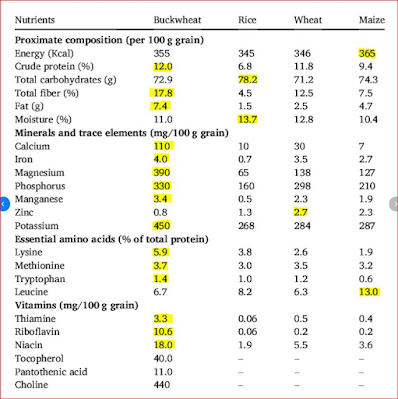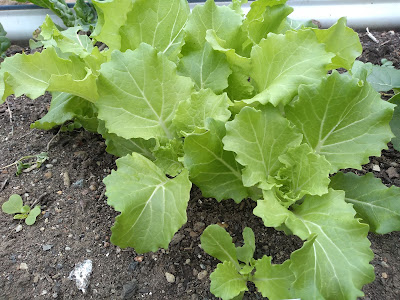Much like a seahorse is not a horse, buckwheat (Fagopyrum esculentum) is not related to wheat (Triticum aestivum). Other than their common names, and that they are both edible, buckwheat and wheat don't have much in common.
While buckwheat and wheat are both angiosperms (vascular flowering plants), that is almost where the similarity ends. Wheat is a monocot, while buckwheat is a dicot, as far as flowering plants go you can't get much more different than that.
Both plants are edible, both can be eaten in similar ways. Both are popular breakfast foods, as well as being popular for animal feed, and both feed a tremendous number of humans across the world every day. Both have edible leaves and stems, but I want to discuss the seed/fruit of buckwheat.
Wheat contains gluten, buckwheat does not. Wheat is low in several essential amino acids (eg lysine and threonine) and is not considered to be complete protein.
Buckwheat contains high quality complete protein with decent quantities of all of the essential amino acids. Buckwheat is rich in limiting amino acids like lysine and arginine, which are in shortest supply in plant-based diets and is pretty rare among plant foods. For this reason, buckwheat is considered to be a complete protein.
 |
| Some buckwheat that I grew |
Buckwheat nutritional value
It is difficult finding nutritional data on anything that is overly consistent. Sometimes these differences come down to what exactly is being tested, or different varieties, or seasonal variations, or even how the test was conducted. For this reason I try to look up several sources of information. Regardless of the source, you will notice that buckwheat is incredibly nutritious for a plant based food.
I found a website that listed the following nutritional value per 100g of buckwheat:
| Principle | Nutrient Value | Percent of RDA |
|---|---|---|
| Energy | 343 Kcal | 17% |
| Carbohydrates | 71.50 g | 55% |
| Protein | 13.25 g | 24% |
| Total Fat | 3.40 g | 17% |
| Cholesterol | 0 mg | 0% |
| Dietary Fiber | 10 g | 26% |
| Vitamins | ||
| Folates (B9) | 30 µg | 7.5% |
| Niacin (B3) | 7.020 mg | 44% |
| Pantothenic acid | 12.33 mg | 25% |
| Riboflavin (B2) | 0.425 mg | 33% |
| Thiamin (B1) | 0.101 mg | 8.5% |
| Vitamin A | 0 IU | 0% |
| Electrolytes | ||
| Sodium | 1 mg | <1% |
| Potassium | 460 mg | 10% |
| Minerals | ||
| Calcium | 18 mg | 2% |
| Copper | 1.100 mg | 122% |
| Iron | 2.20 mg | 27.5% |
| Magnesium | 231 mg | 58% |
| Manganese | 1.300 mg | 56.5% |
| Phosphorus | 347 mg | 50% |
| Selenium | 8.3 µg | 15% |
| Zinc | 2.40 mg | 22% |
| Amino acids | ||
| Lysine | 672 mg | 32% |
| Methionine | 172 mg | 24% |
| Tryptophan | 192 mg | 69% |
Buckwheat nutrition compared to Grains
By in large, buckwheat appears to be more nutritious than any of the true grains that were tested in that sample:
 |
| Comparison of nutrition: Buckwheat, Rice, Wheat, and Maize |
Buckwheat vitamins compared to wheat
Thiamin (B1) buckwheat 3.3mg, wheat 0.5mg, RDI 1.5mg
Riboflavin (B2) buckwheat 10.8mg, wheat 0.2mg, RDI 1.8mg
Niacin (B3) buckwheat 18, wheat 5.5, RDI 20
Magnesium, buckwheat 390mg, wheat 138mg, RDI 400mg
Vitamin K (phylloquinone) buckwheat 7.00 µg, wheat 0.3 µg, RDI 80 µg
Vitamin A (retinol) like all grains, none.
Buckwheat compared to Oats
Oats (Avena sativa) are another popular breakfast food. Oat is a monocot and is similar to wheat in many ways. Unlike wheat, oats do not contain gluten. Oats, much like buckwheat, are meant to naturally lower total cholesterol levels and improve HDL to LDL cholesterol ratio.
I use buckwheat to make kasha for my breakfast each morning, which is similar to how many people eat steel cut oats. I tried eating oaten kasha for some time, but found I was getting hungry early in the day. When I make kasha using buckwheat I feel full for longer, which is nice.
I fount a web page with the following comparison table of buckwheat and oats. Once again buckwheat comes out as an impressively nutritious food. These results indicate that buckwheat is more nutritious than oats.
| per 100g | Buckwheat | Oatmeal |
|---|---|---|
| Calories | 343 | 68 |
| Carbohydrates | 71.5 g | 11.67 g |
| Fat | 3.4 g | 1.36 g |
| Dietary fiber | 10 g | 1.7 g |
| Protein | 13.25 g | 2.37 g |
| Calcium | 18 mg | 80 mg |
| Iron | 2.2 mg | 5.96 mg |
| Magnesium | 231 mg | 26 mg |
| Phosphorus | 347 mg | 77 mg |
| Potassium | 460 mg | 61 mg |
| Sodium | 1 mg | 49 mg |
| Zink | 2.4 mg | 0.62 mg |
| Vitamin B2 (riboflavin) | 0.425 mg | 0.215 mg |
| Vitamin B3 (Niacin) | 7.02 mg | 3.025 mg |
| Vitamin B5 | 1.233 mg | 0.317 mg |
| Vitamin B9 (Folic acid) | 30 mg | 39 mg |
Buckwheat Glycemic index compared to grains
The lowest GI was found for buckwheat (34.7±8.2%) and barley (31.3±13.4%). The GL for these groats was 8.1±1.9 and 8.0±3.4, respectively. The GI for millet, spelt and bulgur amounted to 56.2±20.6%, 69.8±35.0%, 64.5±36.8%, respectively, while for couscous amounted to 99.0± 36.0%. The highest GL was observed for couscous (24.7±9.0).
The groats tested in that study classified barley and buckwheat as low GI food, millet and bulgur as medium GI food, spelt and couscous as a high GI food. The study concluded that buckwheat and barley should be chosen the most often among these products, while the intake of couscous should be limited, especially by people with diabetes.









































